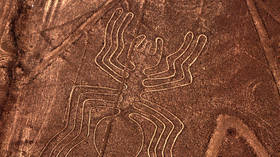Over 100 animal carvings discovered in Peruvian desert

Peruvian and Japanese archaeologists have discovered 168 new designs carved into Peru’s Nazca plain and its surroundings after photographing the site with drones for two years. Unlike the more abstract Nazca Lines, which are only visible from the air, the newly-discovered glyphs can be seen from the ground, lead researcher Masato Sakai of Yamagata University told Reuters on Monday.
The carvings, located about 250 miles south of Lima on Peru’s coast, depict humans, cats, snakes, whales, birds, llamas, alpacas and other creatures and date back more than 2,000 years, according to the researchers. The newfound images measure about 2 to 6 meters in length, while the previously-discovered lines extend as long as 30 miles.
Since 2004, researchers have found 190 figures in the area, and more are believed to be awaiting discovery. The new depictions will be used in artificial intelligence-based surveys to help preserve as-yet-undiscovered carvings, which are in danger of destruction “due to the recent expansion of mining-related workshops in the archaeological park,” according to Sakai.
The lines were created by removing several layers of dark-colored rocks to leave the light-colored sand underneath, and the lack of precipitation and wind in the intervening centuries have left the resulting designs largely intact. Archaeologists have been unable to agree on the purpose of the designs. Some believe they were used in religious rituals, while others think they served an astronomical purpose.












